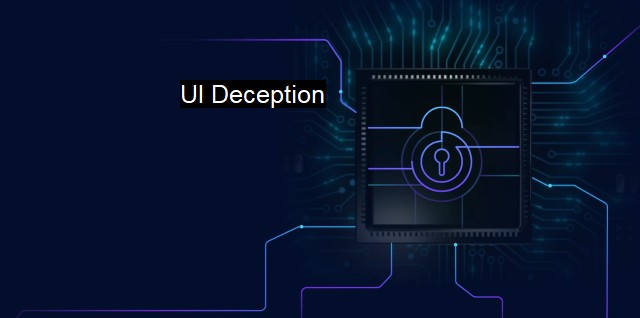What is UI Deception?
Uncovering the Threat of UI Deception and Social Engineering in Cybersecurity: A Look at the Increasingly Sophisticated Tactics of Cyber Attacks
UI Deception, otherwise known as User Interface Deception, is a cyber-security concept that revolves around the misuse of graphical user interface (GUI) elements to trick users into performing actions that may compromise their online security. This tactic takes advantage of the user's trust and familiarity with certain interfaces or visual elements to lead them into engaging with fraudulent or malicious content.Using a range of tactics, cyber attackers mimic the look and feel of legitimate software or webpages to deceive users. For instance, a deceptive UI might resemble popular social network sites, online banking portals or email platforms to stun users into submitting personal or financial information. Notably, these techniques do not rely upon any technical vulnerabilities within the operating systems – but rather, they exploit human susceptibilities to visual cues and implied social conventions.
In a broad sense, UI deception tactics often overlap with phishing and social engineering attacks. A persistent problem presented by UI deception is the constant evolution and refinement of tactics employed by the cyber criminals; as security systems become more sophisticated, so do the attempts to infiltrate them.
One type of UI deception is referred to as "clickjacking", or UI redressing. This happens when an attacker uses multiple transparent or opaque layers to trick a user into clicking on a button or link on another page unknowingly. While they believe they are clicking one interface, the command sent is different and often malicious.
A typical example may involve an innocent-looking button that says, "Click here to win a prize!" While the button exists on a transparent layer hovering over a submit button that says, "Delete all my files.” When the user clicks to "win a prize" they are unknowingly consent to delete all their files.
Another form of UI deception exploit involves Cursor Spoofing. In this technique, the attacker changes the appearance of the user's cursor to mislead the user during their interaction with the application. The right place to click might be manipulated relative to the position or appearance of the cursor, which then tricks the users into performing unwanted actions.
UI deception also extends to well-designed false warning messages or engine notifications. These alerts will mimic legitimate software alerts persuading the user that they must download a particular program or click on a particular link to resolve an issue. Upon performing the action as per the alert, the users often subject their systems or data to the attackers.
Learning to avoid UI deception involves a high level of user education and awareness. This can be cultivated by timely graphical and contextual clues, distinguishing between different types of user interfaces, purposive design measures to guard against wrong actions and tight security configurations.
Antivirus softwares have a crucial role in countering UI deception. They often come built-in with features that can identify, block or warn users when they encounter sites or software employing these tactics. Regular updates of these antivirus programs are essential to adapt to the continuously evolving methods employed by malicious actors.
Despite these challenges, the prevalence of UI deception continues to highlight the ongoing importance of vigilance, public awareness, and sophisticated security measures needed to safeguard users and systems from potential harm. It underscores the symbiotic relationship between technological advances and human susceptibility to deception, indicating the security landscape will continually be marked by reactive strategies to new types of deceits exploited through the user interface. The cyber battleground is far from limited to technological espionage but intrinsically tied to manipulating people's perceptions and interaction habits with technology.
UI deception stands out, not so much for being an emerging form of cyber malfeasance, but for repurposing old conning strategies into a new, digital context. Such repurposing underscores the multi-faceted nature of cyber-security landscapes and the critical role of secure user interface designs in safeguarding user data effectively.

UI Deception FAQs
What is UI deception in cybersecurity?
UI deception is a technique used in cybersecurity to trick attackers into believing that they have access to a certain interface or system when in reality, they have been diverted to a fake interface.How does UI deception protect against antivirus attacks?
UI deception can be used to mislead an attacker into thinking that they have compromised a system or endpoint device. This technique can be used to lead attackers into a trap where they can be identified and stopped before they can cause any harm.What are some examples of UI deception?
UI deception can be achieved using a variety of methods including creating fake login pages, fake update notifications, or fake error messages. Another example is creating a honeypot system, which is designed to attract attackers and capture their activities.How effective is UI deception in cybersecurity?
UI deception can be an effective cybersecurity technique if used appropriately. It can mislead attackers and prevent them from causing harm to a system or organization. However, it should not be relied upon as the sole method of defense and should be used in conjunction with other security measures such as antivirus software, firewalls, and intrusion detection systems.| | A | | | B | | | C | | | D | | | E | | | F | | | G | | | H | | | I | | | J | | | K | | | L | | | M | |
| | N | | | O | | | P | | | Q | | | R | | | S | | | T | | | U | | | V | | | W | | | X | | | Y | | | Z | |
| | 1 | | | 2 | | | 3 | | | 4 | | | 7 | | | 8 | | |||||||